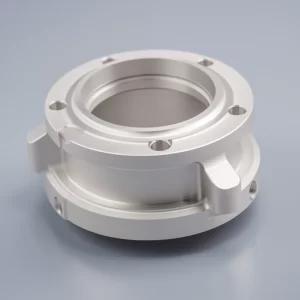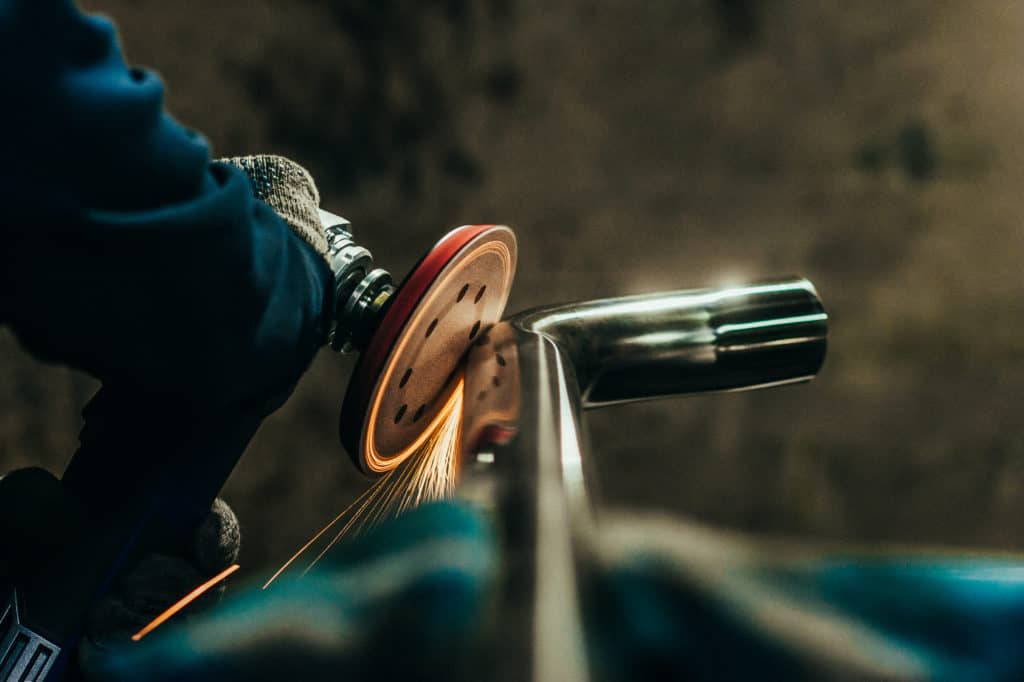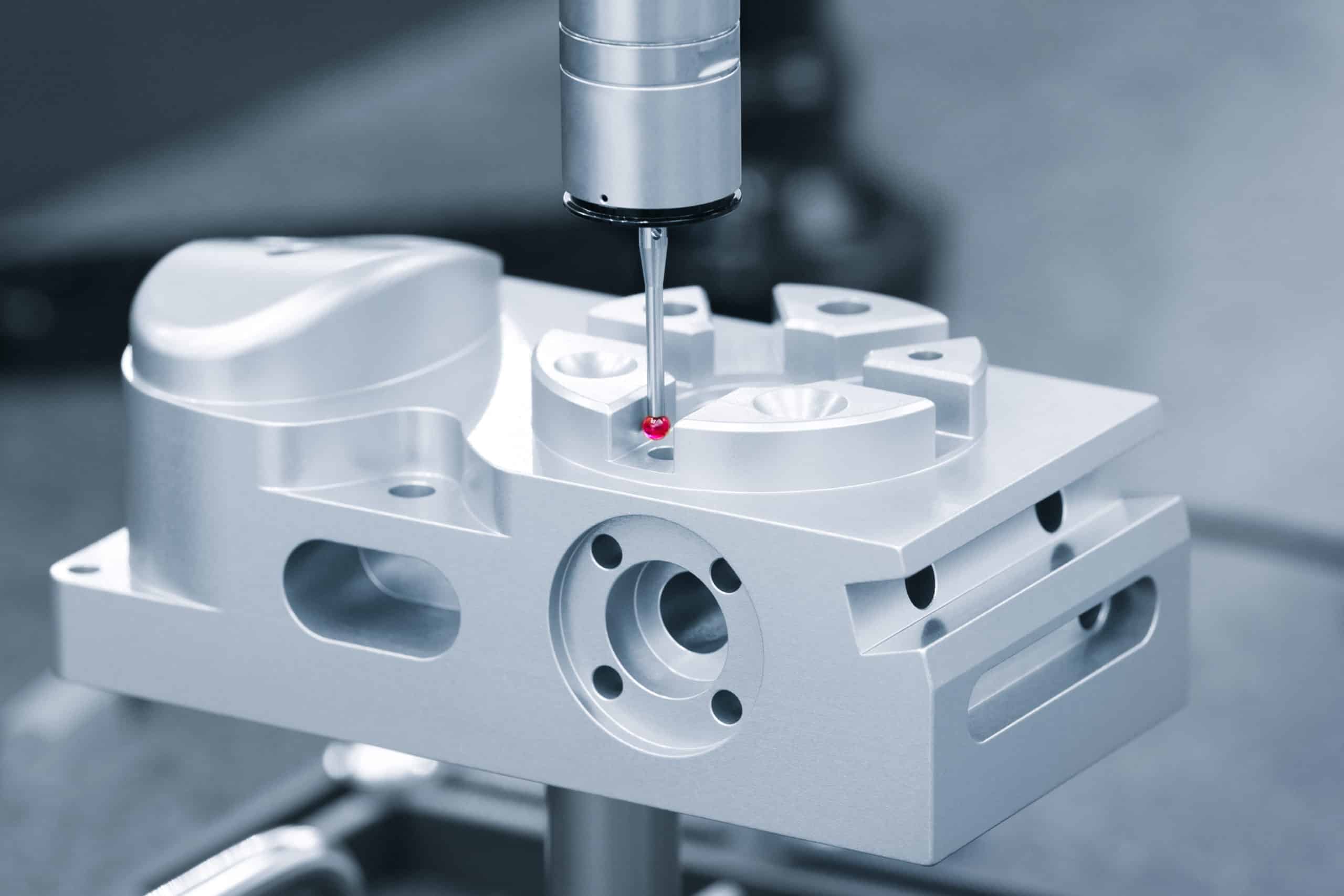Many engineers assume titanium anodizing works like aluminum anodizing — but the processes and results differ significantly. With experience anodizing titanium for medical and aerospace applications, we’ll clarify what titanium anodizing can and can’t do compared to aluminum.
No, titanium anodizing works differently than aluminum anodizing. Titanium creates much thinner oxide layers (0.0001-0.0005″), offers different color mechanisms, and provides unique biocompatibility advantages. While aluminum anodizing builds substantial coating thickness, titanium anodizing preserves tight tolerances but requires different specification approaches and expectations.
Discover coating, color, and grade differences in titanium anodizing—plus how to specify it correctly to avoid costly surprises in production.
Table of Contents
What titanium grades work best with anodizing?
Grade 2 (commercially pure) and Grade 5 (Ti-6Al-4V) are the most commonly anodized titanium alloys, offering excellent color response and surface quality. Grade 2 provides the most vibrant colors and easiest machining, while Grade 5 delivers superior strength with slightly more muted colors. Both grades are readily available and well-suited for most anodizing applications.
Quick Selection Guide:
- Choose Grade 2 if: Appearance-critical, cost-sensitive, easier machining required
- Choose Grade 5 if: High strength needed, structural loads, aerospace specifications
- Choose Grade 9 if: Moderate strength acceptable, can wait 2-3 weeks for material
From our anodizing experience, Grade 2 consistently delivers the most uniform color appearance across batch runs, making it ideal for medical housings and visible components. Grade 5 shows slight color variation due to alloying elements but provides significantly higher tensile strength for structural applications. Both grades demonstrate excellent coating adhesion when processed according to ASTM F86 anodizing standards.
Material Comparison:
Grade Strength Color Quality Cost Machining Availability
Grade 2 Moderate Excellent Baseline Easy Stock
Grade 5 High Good +25–30% Harder Stock
Grade 9 Good Good +15–20% Moderate 2–3 weeks
Design Takeaway: Grade 2 delivers maximum color consistency and lowest total cost for most applications. Reserve Grade 5 for structural parts requiring high strength-to-weight ratios. Always specify grade clearly since anodizing parameters differ between alloys.
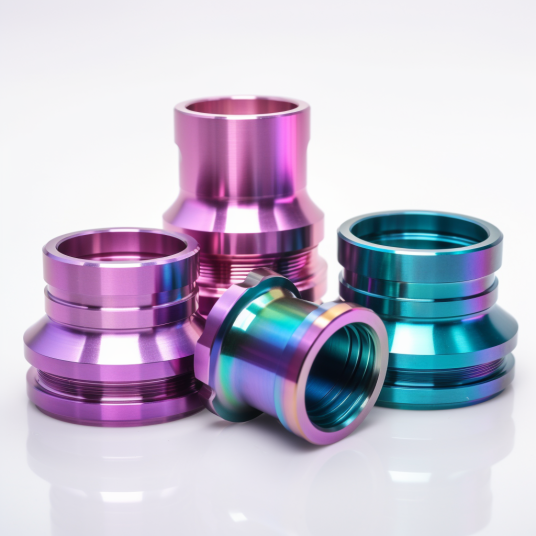
Will anodizing change the size or tolerance of my titanium part?
Titanium anodizing adds only 0.0001-0.0005″ (2.5-12.5 µm) to part dimensions – significantly thinner than aluminum anodizing’s 0.0005-0.002″ buildup. This minimal coating thickness preserves tight tolerances and critical fits, making titanium anodizing suitable for precision assemblies where aluminum anodizing would cause interference.
From our precision machining experience, we routinely hold ±0.001″ tolerances on anodized titanium parts without dimensional compensation. Critical bearing surfaces, threaded features, and press-fit areas typically remain functional after anodizing. However, we recommend checking clearances on extremely tight assemblies (±0.0005″ or tighter) since even minimal coating buildup can affect fit.
Standard machine threads (6-32, 1/4-20) function normally after titanium anodizing, but precision Class 3 fits may require pre-anodizing dimensional adjustments.
Design Takeaway: Unlike aluminum anodizing, titanium anodizing rarely requires dimensional compensation. Reserve tolerance adjustments only for ultra-precision fits tighter than ±0.0005″.
Is titanium anodizing just for color, or does it improve mechanical performance?
Titanium anodizing provides both decorative colors and functional benefits including improved corrosion resistance, enhanced biocompatibility, and better wear characteristics. Unlike aluminum anodizing, titanium creates a controlled oxide layer that maintains electrical conductivity while reducing galling and surface wear.
Choose titanium anodizing for performance when:
- Corrosion resistance needed: 3-5x improvement over bare titanium
- Biocompatibility critical: Medical device applications requiring reduced ion release
- Electrical conductivity acceptable: 10-15 ohms/sq surface resistance
- Wear reduction required: 40-60% less surface degradation
From our testing, anodized titanium samples show 3-5 times longer corrosion resistance in salt spray environments, extending service life in marine or chemical applications. Operating temperature limits reach 450°F before color degradation, suitable for most industrial environments.
Electrical performance remains excellent for grounding applications. Surface resistance increases to 10-15 ohms/square compared to bare titanium, but maintains adequate conductivity for electronics housings and EMI shielding.
Medical applications benefit from enhanced biocompatibility meeting ISO 10993 standards, with reduced titanium ion release and color coding for sterile identification. Wear testing shows 40-60% reduction in surface degradation compared to untreated titanium.
Design Takeaway: Specify titanium anodizing when you need both color identification and functional performance improvements. The 15-25% cost premium is justified by extended service life and enhanced properties in demanding applications.
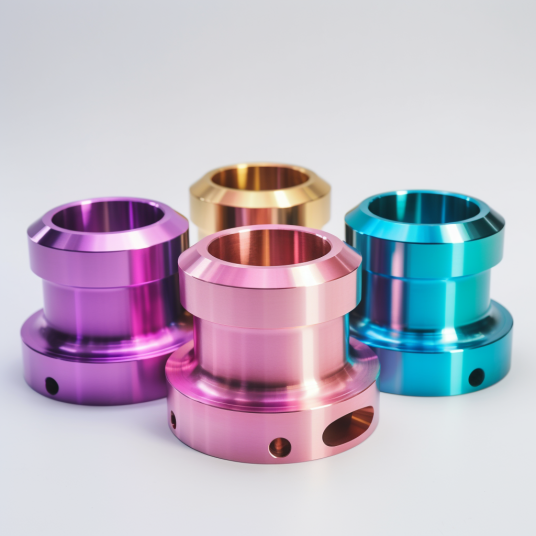
Can I expect color consistency in titanium anodized parts?
Titanium anodizing provides good color consistency within single batches (±5% variation) but shows more variation between production runs (±10-15%). Single-batch processing delivers the best color matching for multi-part assemblies, while multiple batches work for individual components where exact matching isn’t critical.
Color Consistency Decision Framework:
- Choose single-batch when: Color matching critical, visible assemblies, budget allows premium
- Accept multi-batch when: Individual components, color tolerance acceptable, cost-sensitive projects
- Specify color ranges when: Multiple production runs required, exact matching impossible
Color Consistency Expectations:
Batch Type Color Variation Cost Impact Best Applications
Single Batch ±5% color shift +15–20% Matched assemblies
Multiple Batches ±10–15% shift Standard Individual components
Different Grades ±20% shift Standard Avoid for assemblies
From our anodizing experience, parts processed simultaneously in the same electrolyte bath show excellent color matching suitable for visible assemblies. However, titanium’s voltage-dependent color generation means even small electrical variations can create noticeable differences. Surface finish significantly affects final appearance – parts with Ra 32µin (0.8µm) or better produce more uniform colors than rougher surfaces.
Temperature and electrolyte age also influence color development. According to ASTM F86 anodizing standards, processing temperature variations of ±5°F can shift colors noticeably in sensitive ranges like blues and purples.
Design Takeaway: Plan for single-batch processing when color matching is critical, accepting the 15-20% cost premium. Specify consistent surface finishes (Ra 32µin max) and consider color tolerance ranges rather than exact matches for cost-effective multi-batch production.
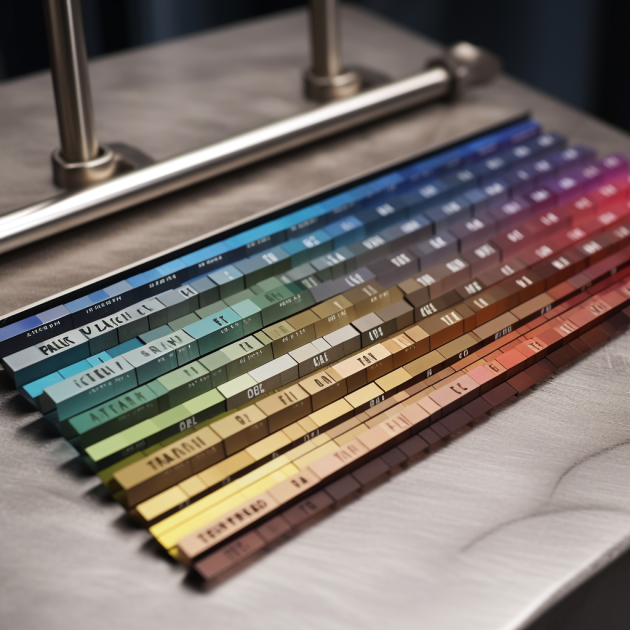
Can I mask specific areas during titanium anodizing?
Yes, specific areas can be masked during titanium anodizing using specialized tapes, plugs, or fixtures to protect threads, bearing surfaces, or electrical contacts. Masking prevents anodizing buildup on critical dimensions while allowing color development on visible areas. However, masking adds 20-30% to anodizing costs and has geometric limitations that may require design modifications.
Masking Decision Framework:
- Choose masking when: External threads, flat surfaces, holes >0.125″, cost premium acceptable
- Avoid masking when: Complex internals, holes <0.125″, cost-sensitive projects
- Consider post-machining when: Ultra-tight tolerances, high-volume production, complex geometry
Masking Feasibility Guide:
Feature Type Minimum Size Masking Success Setup Time
External threads #6-32 and larger Excellent 5–10 min
Through holes 0.125″ diameter Good 2–5 min
Flat surfaces Any size Excellent 1–2 min
Internal features 0.25″ access Poor 15+ min
From our masking experience, we’ve successfully masked 1/4-20 threads using custom silicone plugs, but struggled with #4-40 threads due to plug size limitations and removal difficulties. High-temperature polyimide tape works excellently on flat surfaces and external geometries where clean removal is possible. Features requiring 90-degree access angles or smaller than 0.125″ diameter typically fail masking attempts despite careful preparation.
Design considerations significantly impact masking cost-effectiveness. Accessible external features cost 20-30% more to anodize, while complex internal masking can increase costs by 75-100% due to custom fixture requirements. According to ASTM F86 anodizing guidelines, masked areas must maintain complete electrolyte exclusion to prevent partial anodizing and color variation.
For drawing specifications, clearly indicate masked areas with notes like “MASK THREADS – NO ANODIZING” and dimension critical features separately from anodized surfaces to avoid tolerance confusion.
Design Takeaway: Masking works best for external threads and flat surfaces with easy access. For holes smaller than 0.125″ or complex internal features, design for post-anodizing machining to avoid masking complications and cost premiums.
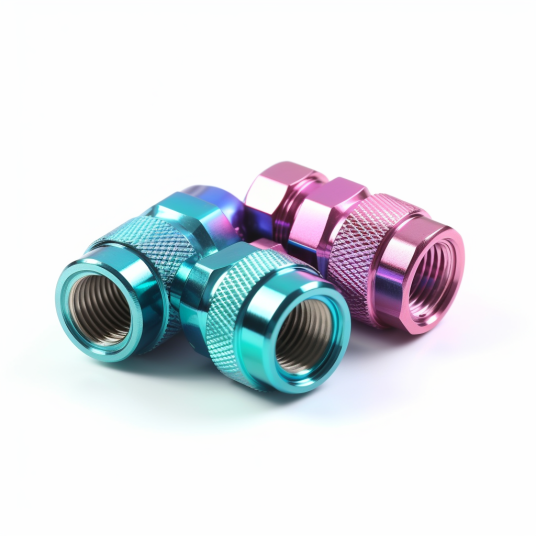
Can I use anodized titanium in medical or aerospace applications?
Yes, anodized titanium is widely used in both medical and aerospace applications due to enhanced biocompatibility, corrosion resistance, and compliance with industry standards. Medical applications benefit from reduced ion release and color coding capabilities, while aerospace uses leverage improved corrosion resistance and galling reduction without weight penalties. Both industries have established protocols for anodized titanium components.
Application Suitability Guide:
- Medical devices: Excellent – meets ISO 10993 biocompatibility, reduces ion migration
- Aerospace structural: Good – improves corrosion resistance, maintains strength-to-weight
- Implantable devices: Excellent – enhanced biocompatibility over bare titanium
- Flight-critical parts: Requires qualification – verify with specific aerospace standards
Industry Compliance Overview:
Application Key Standards Benefits Considerations
Medical Devices ISO 10993, FDA 510(k) Biocompatibility, color coding Validation testing required
Aerospace AS9100, ASTM F86 Corrosion resistance, galling reduction Material certification needed
Implants ISO 14630, ASTM F136 Reduced ion release, osseointegration Long-term studies available
From our experience with medical device manufacturers, anodized titanium surgical instruments show significantly reduced tissue staining compared to bare titanium, while maintaining sterilization compatibility. Aerospace customers use anodized titanium fasteners and brackets where corrosion resistance extends service intervals without adding weight. The controlled oxide layer provides 3-5x better salt spray resistance than untreated titanium.
Regulatory approval processes vary by application. Medical devices typically require biocompatibility testing per ISO 10993-5 and 10993-10, while aerospace applications need material certification and process validation. According to ASTM F86 and F136 standards, properly anodized titanium maintains base material properties while improving surface characteristics.
Design Takeaway: Anodized titanium excels in both medical and aerospace applications where biocompatibility, corrosion resistance, and weight considerations are critical. Plan for industry-specific testing and certification requirements during design validation phases.
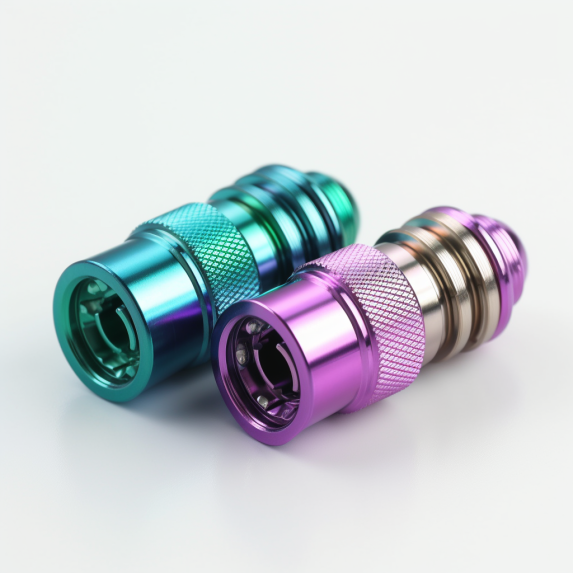
What anodizing specifications should I include on my titanium drawings?
Include anodizing type, color specification, masking requirements, and applicable standards on your titanium drawings to ensure consistent results. Clear specifications prevent manufacturing confusion and costly rework. Essential callouts include surface preparation requirements, dimensional tolerances, and inspection criteria for proper quality control.
From our drawing review experience, unclear anodizing specifications cause 60% of production delays and rework issues. The most effective approach combines process standards with specific color references and clear masking instructions. A typical drawing note should read: “ANODIZE TYPE II PER ASTM F86, BLUE – RAL 5005, MASK THREADED HOLES.”
Surface preparation requirements significantly impact final quality. Specify “Ra 32μin max before anodizing” for consistent color development. Dimensional callouts should clarify whether tolerances apply after anodizing using “DIMENSIONS APPLY AFTER ANODIZING UNLESS NOTED” since titanium’s minimal coating thickness preserves most tolerances.
Supplier qualification becomes critical for consistent results. Qualified shops should demonstrate ASTM F86 certification and provide color consistency data from previous jobs. When evaluating suppliers, ask for process control charts and examples of successful masking on similar geometries.
Common specification mistakes include: requiring exact Pantone colors (titanium has limited color range), over-tolerancing non-critical dimensions, and unclear masking instructions that lead to production confusion.
Design Takeaway: Use specific, measurable callouts rather than vague descriptions. Include clear process standards, color references, and masking instructions to prevent costly rework and ensure consistent anodizing results from qualified suppliers.

Conclusion
Titanium anodizing differs significantly from aluminum anodizing in coating thickness, color mechanisms, and application benefits, but offers superior biocompatibility and corrosion resistance for precision applications. Proper material selection, realistic tolerance expectations, and clear drawing specifications ensure successful results. Contact us to explore titanium anodizing solutions tailored to your precision component requirements
Frequently Asked Questions
Grade 5 (Ti-6Al-4V) provides the optimal balance with high tensile strength (130 ksi) and good anodizing response. While Grade 2 delivers superior color consistency, Grade 5’s structural performance justifies the 25-30% material cost premium for load-bearing applications.
Titanium anodizing typically costs 2-3x more than aluminum due to specialized equipment, longer processing times, and material handling requirements. However, the thinner coating and enhanced properties often justify the premium for precision applications requiring biocompatibility or superior corrosion resistance.
Single-batch processing achieves ±5% color consistency suitable for most assemblies. Exact color matching across multiple production runs is difficult due to voltage sensitivity. Specify color tolerance ranges rather than exact matches for cost-effective multi-batch production.
Holes smaller than 0.125″ diameter are difficult to mask effectively due to plug size limitations and removal challenges. For #6-32 threads and larger, masking works well, but smaller features often require post-anodizing machining for better cost-effectiveness.
Titanium anodizing adds only 0.0001-0.0005″ thickness, so tolerances of ±0.001″ or looser typically remain unaffected. For ultra-precision fits tighter than ±0.0005″, verify clearances since even minimal coating buildup can cause interference in critical assemblies.
Yes, anodized titanium maintains adequate conductivity for most grounding applications with surface resistance of 10-15 ohms/square. While higher than bare titanium, this remains suitable for electronics housings and EMI shielding where painted finishes would exceed 100 ohms/square.



